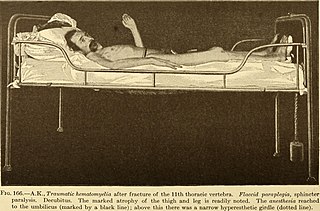Related Research Articles

Paraplegia, or paraparesis, is an impairment in motor or sensory function of the lower extremities. The word comes from Ionic Greek (παραπληγίη) "half-stricken". It is usually caused by spinal cord injury or a congenital condition that affects the neural (brain) elements of the spinal canal. The area of the spinal canal that is affected in paraplegia is either the thoracic, lumbar, or sacral regions. If four limbs are affected by paralysis, tetraplegia or quadriplegia is the correct term. If only one limb is affected, the correct term is monoplegia. Spastic paraplegia is a form of paraplegia defined by spasticity of the affected muscles, rather than flaccid paralysis.

Richard Marvin Hansen is a Canadian track and field athlete, activist, and philanthropist for people with disabilities. Following a pickup truck crash at the age of 15, Hansen sustained a spinal cord injury and became a paraplegic. Hansen is most famous for his Man in Motion World Tour, in which he circled the globe in a wheelchair to raise funds for charity. He was inducted into Canada's Sports Hall of Fame in 2006. He was one of the final torchbearers in the 1988 Winter Olympics and the 2010 Winter Olympics. He was profiled and spoke during the 2010 Winter Paralympics opening ceremony.

A standing frame is assistive technology that can be used by a person who relies on a wheelchair for mobility. A standing frame provides alternative positioning to sitting in a wheelchair by supporting the person in the standing position.
WheelPower is the national organisation for wheelchair sports in the United Kingdom, and aims to help people with disabilities improve their quality of life.

A mobility assistance dog or mobility service dog is a dog trained to assist a physically disabled person who has mobility issues, such as poor balance or being a non-ambulatory wheelchair user. Roles include "providing balance and stability" picking up and carrying objects, pulling wheelchairs, opening and closing doors, and operating light switches. Mobility assistance dogs can have significant positive impacts on the lives of their handlers.

Wheelchair racing is the racing of wheelchairs in track and road races. Wheelchair racing is open to athletes with any qualifying type of disability, including leg amputees, spinal cord injuries, and cerebral palsy. Athletes are classified in accordance with the nature and severity of their disability or combinations of disabilities. Like running, it can take place on a track or as a road race. The main competitions take place at the Summer Paralympics which wheelchair racing and athletics has been a part of since 1960. Competitors compete in specialized wheelchairs which allow the athletes to reach speeds of 30 km/h (18.6 mph) or more. It is one of the most prominent forms of Paralympic athletics.
Spinal Cord Injury BC is a not-for-profit organization that helps people with spinal cord injuries and related injuries adjust, adapt and thrive by providing answers, information and community experiences in the Canadian province of British Columbia.
Disaboom was a social networking service for people with disabilities, as well as their family members, friends, caregivers, and employers.

Christopher Voelker was an American photographer.

The Summer Paralympics, also known as the Games of the Paralympiad, are an international multi-sport event where athletes with physical disabilities compete. This includes athletes with mobility disabilities, amputations, blindness, and cerebral palsy. The Paralympic Games are held every four years, organized by the International Paralympic Committee. Medals are awarded in every event, with gold medals for first place, silver for second and bronze for third, a tradition that the Olympic Games started in 1904.

Sexuality and disability is a topic regarding the sexual behavior and practices of people with disabilities. Like the general population, these individuals exhibit a wide range of sexual desires and adopt diverse methods of expressing their sexuality. It is a widespread concern, however, that many people with disabilities do not receive comprehensive sex education, which could otherwise positively contribute to their sexual lives. This roots from the idea that people with disabilities are asexual in nature and are not sexually active. Although some people with disabilities identify as asexual, generalizing this label to all such individuals is a misconception. Many people with disabilities lack rights and privileges that would enable them to have intimacy and relationships. When it comes to sexuality and disability there is a sexual discourse that surrounds it. The intersection of sexuality and disability is often associated with victimization, abuse, and purity.

The QuadPara Association of South Africa (QASA) was established in 1978 as a non-profit organisation which strives to prevent spinal cord injury through high-profile information campaigns, as well as to protect and promote the interests of people with mobility impairments through lobbying and advocacy.
Magee Rehabilitation Hospital, part of Jefferson Health, founded in 1958, is a 96-bed specialty medical rehabilitation hospital providing physical and cognitive rehabilitation services. Magee's flagship facility is located in Center City Philadelphia. In addition to the main campus that offers comprehensive services for spinal cord injury, brain injury, stroke, orthopaedic replacement, amputation, pain management and work injury, Magee provides an expanding outpatient network serving the surrounding communities. In 1985, Magee's brain injury rehabilitation program became the first in the nation to be accredited by the Commission on the Accreditation of Rehabilitation Facilities. Magee partnered with Jefferson Hospital to create one of the nation's 14 federally designated centers for spinal cord injury rehabilitation. Magee has been rated one of America's leading rehabilitation hospitals by U.S. News & World Report. Magee provides treatment to more than 5,000 individuals annually. Magee is authorized to treat wounded military personnel returning from war. Magee is not an Obligated Group Affiliate.
The Sporting Wheelies and Disabled Association is the peak body for sport, recreation and fitness for people with a physical disability or vision impairment in the Australian state of Queensland.
Wheelchair fencing classification is the classification system for wheelchair fencing which is governed by the IWAS. People with physical disabilities are eligible to compete included people with physical disabilities. Classification for national competitions is done through the local national Paralympic committee.

Although spinal cord injury (SCI) often causes sexual dysfunction, many people with SCI are able to have satisfying sex lives. Physical limitations acquired from SCI affect sexual function and sexuality in broader areas, which in turn has important effects on quality of life. Damage to the spinal cord impairs its ability to transmit messages between the brain and parts of the body below the level of the lesion. This results in lost or reduced sensation and muscle motion, and affects orgasm, erection, ejaculation, and vaginal lubrication. More indirect causes of sexual dysfunction include pain, weakness, and side effects of medications. Psycho-social causes include depression and altered self-image. Many people with SCI have satisfying sex lives, and many experience sexual arousal and orgasm. People with SCI may employ a variety of adaptations to help carry on their sex lives healthily, by focusing on different areas of the body and types of sexual acts. Neural plasticity may account for increases in sensitivity in parts of the body that have not lost sensation, so people often find newly sensitive erotic areas of the skin in erogenous zones or near borders between areas of preserved and lost sensation.

Anthony Eric "Tony" South OAM AM is an Australian Paralympic archer who won a gold medal and two silver medals at the 1968 Summer Paralympics and a bronze medal at the 1972 Summer Paralympics.
F5, also SP5, is a wheelchair sport classification that corresponds to the neurological level T8 - L1. Historically, it was known as Lower 3, or Upper 4. People in this class have some trunk function and good sitting balance. They have problems with hip function, that reduces their ability to rotate their spines.
Wheelchair sport classification is a system designed to allow fair competition between people of different disabilities, and minimize the impact of a person's specific disability on the outcome of a competition. Wheelchair sports is associated with spinal cord injuries, and includes a number of different types of disabilities including paraplegia, quadriplegia, muscular dystrophy, post-polio syndrome and spina bifida. The disability must meet minimal body function impairment requirements. Wheelchair sport and sport for people with spinal cord injuries is often based on the location of lesions on the spinal cord and their association with physical disability and functionality.
Barry Corbet was an American mountaineer, film maker and an author. He was a member of the first U.S. Team to climb Mt. Everest. Corbet produced or co-produced more than 100 films and was editor of New Mobility, a magazine on disability culture and lifestyle. He wrote extensively on disability related issues. His book, Options: Spinal Cord Injury and the Future, was published in 1980.
References
- ↑ Utne Reader Independent Press Awards 2006
- ↑ "New Mobility Magazine Identifies 17 Big Ideas That Could Change The World For Wheelchair Users". PR Newswire. 10 September 2019. Retrieved 20 April 2020.
- ↑ "Celebrating Tim". 2 July 2018. Retrieved 3 July 2023.
- ↑ "Meet the team" . Retrieved 3 July 2023.
- ↑ John Young Lecture by Barry Corbet
- ↑ Sex and the Disabled: Still a Taboo Topic